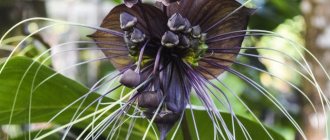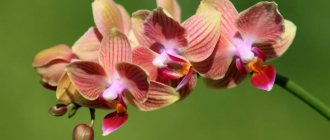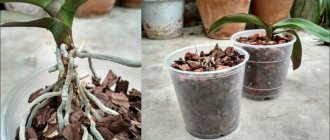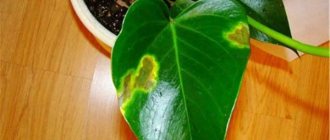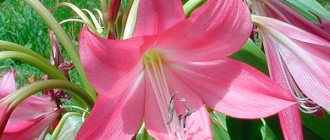Judging by the appearance of the orchid, the plant is already quite mature, and its root system is thoroughly rotten. As a result, the leaves began to wither and turn yellow, since the rotted roots were no longer able to provide them with moisture. However, it is quite possible to save the flower, because the upper part of the main root seems to be still alive. Upon closer inspection, dormant buds should be visible.
To resuscitate an orchid, it is necessary to carry out a number of manipulations:
- thoroughly clean the plant from rotten residues;
- process the flower;
- prepare the pot and substrate;
- plant an orchid.
Removing rotten parts of an orchid
Before replanting a flower, you should remove not only the dried roots. The photo shows that the main root has also rotted - it is black. Using sharp scissors or a knife, cut off the entire blackened part of the root to the beginning of living (green) tissue. Only hard, elastic, light-colored roots with a green tint can be left.
Before pruning, tools must be disinfected.
Yellowed leaves also need to be removed: cut the leaf lengthwise with scissors and gently pull it in different directions at the base.
Orchid processing
After trimming damaged tissue, rinse the remaining root system in a weak solution of potassium permanganate. Wipe the leaves themselves with a damp cloth soaked in the same solution. Next, sprinkle all cut areas with activated carbon. You can use regular cinnamon for these purposes.
To stimulate root formation, experienced gardeners recommend soaking the roots of the plant before planting in a solution of the drug Epin (1 drop per liter of water).
Now you need to let the orchid dry thoroughly. The drying time should be at least 3 hours, and it is even better to carry out all the preparatory work in the evening and leave the plant overnight. During this time, all moisture will evaporate, including from hard-to-reach places, such as an outlet. In addition, the cut areas will tighten a little.
Why do orchids need potassium permanganate?
Dark brown crystals are used to obtain a solution that has a positive effect on most plants. Potassium permanganate for orchids is used in the following cases:
- To combat insects such as white midges. But this product is not intended for pest control, so its effectiveness is extremely low.
- For disinfecting soil under flowers. The drug solution eliminates the risk of late blight, gray rot, powdery mildew and other infectious lesions. When frequently watering the soil with potassium permanganate, the possibility of drying of the roots must be taken into account.
- To accelerate plant growth. The drug is mixed with boric acid and the resulting mixture is watered on the bushes. This procedure accelerates the appearance of ovaries and the development of buds. Suitable for berry bushes, indoor tomatoes, cucumbers, several types of flowers and other similar plants.
- To clean the underground part of flowers from rot that develops on the bulbs. If cleaned orchid roots are treated with a weak solution of the drug for 10-15 minutes, then all harmful fungi and bacteria will die. This procedure is carried out when transplanting a plant into another soil.
- To stimulate the growth of cuttings or seeds, which are soaked in the solution for half an hour. At the same time, they are disinfected. Not all indoor plants need this procedure.
- As a top dressing if the flower shows signs of potassium deficiency. This procedure must be performed carefully, otherwise the increased concentration of metal can burn the leaves and damage the root system.
Potassium permanganate for indoor flowers.
Potassium permanganate can be used to disinfect bouquets created from cut field or house plants. This will allow the flowers to stay in the vase for 3-4 days longer.
Planting an orchid
Place a drainage layer at the bottom of the pot - it will prevent the roots from rotting due to stagnant water. Sprinkle a little dried substrate on top and place the orchid on it. Carefully place the aerial roots inside the pot. If there are particularly long ones that do not fit into the flowerpot, there is no need to forcibly bend or break them. Let them remain on the surface. Cover the roots placed in the pot with substrate.
To speed up the process of formation of new roots, place the pot with the plant under a cover to avoid rapid evaporation of moisture and to maintain the same air temperature throughout the day. During the first days, it is enough to wipe the leaves with a damp sponge; there is no need to water yet. In the future, watering should be carried out as usual.
Reanimation of an orchid with rotten roots - video
A solution of potassium manganese is a substance that disinfects the soil and stimulates the growth of orchids.
But in order for everything to grow well, you must be able to correctly create a solution and carry out the necessary processing . If done incorrectly, you can burn the plant's root system.
Next, we will look at whether it is possible to treat an orchid with potassium permanganate and how to do it correctly.
Features of caring for blooming Phalaenopsis
The methods used to water a flowering plant are the same as for an orchid without flowers. The difference is that a flourishing culture will require a more attentive, careful approach. She should be kept under constant supervision.
It is especially important to pay attention to the following parameters:
- root color;
- frequency of additional fertilizing;
- fertilizer concentration;
- protection of the peduncle and flowers from water.
Be especially careful when using the shower method.
How to water during flowering?
Flowers are very sensitive to the supply of nutrients. They can quickly wither and fall off if excess fertilizer is applied. It is either not worth watering an orchid with blooming flowers with nutrient solutions, or reduce their frequency. When watering by any method, it is worth removing the water as soon as the buds and flowers get wet.
The safest methods during the flowering period are:
- immersion;
- from a watering can with a narrow neck;
- Irrigation of roots.
How many times a week?
Most likely, flowering Phalaenopsis will have to be moistened more often. Factors affecting watering a flowering plant:
- season;
- acceleration of metabolic processes and fluid needs;
- the plant is located in the sun or shade.
The approximate requirement is twice a week. Flowering usually occurs in a warm period of time: spring or summer. So the soil will dry out in three to four days.
Is it possible to water an orchid with potassium permanganate?
Disinfectant and nutritional properties
If a solution of potassium permanganate is made in the correct proportion, it will help avoid diseases and pests that may appear on the plant. But when using manganese, it is necessary to dilute it as correctly as possible in accordance with the requirements and not water it every time. Since frequent use can dry out the root mass of the plant.
It is very important to prepare a solution of the correct concentration.
Reasons for use
Sometimes, if not properly cared for, a plant develops problems with its root mass. So, with excessive watering, the roots begin to rot. The plant requires replanting with a complete replacement of the soil. And at the moment when the flower is taken out of the old soil, it will need to be inspected and all rotting places removed.
Preparation of the solution
It's easy enough:
- carefully open the bottle of dry potassium permanganate over a newspaper;
- hands must be dry;
- With the tip of a dry knife, literally take a couple of granules and dilute them in warm water ;
- the granules must dissolve completely , since those remaining undissolved will burn the roots or leaves of the plant;
- if the solution turns out to be too pink, then it is diluted to the desired concentration with warm boiled water.
Potassium permanganate granules should completely dissolve in water.
How to make soap solution for orchids?
A solution based on laundry soap helps against aphids, thrips, and spider mites. It's easy to prepare. Dilute 30 grams of crushed soap in 1 liter of hot water, stir until completely dissolved. The plant is completely cooled and processed.
Interesting materials:
What can you eat at night? What can you put in the stroller? What can be fertilized with ash? What can you find out with bronchoscopy? What can you put in Smartavia hand luggage? What can you import into Tanzania? What can you take with you to the pool? What can you take on board the plane besides hand luggage? What can you ask Alice? What is more reliable: hard drive or SSD?
When orchids need revision and maintenance of the root system
Growing orchids in transparent pots is no accident. It is convenient because the condition of the roots is clearly visible through the walls. By their appearance you can determine:
- Timing of watering and fertilizing
- General health of the plant,
- The need for a transplant.
An orchid is a sensitive plant; unless necessary, it should not be moved ahead of time. But, there are circumstances in which, in addition to a planned transplant, rescue work is urgently needed. This can be determined by the following changes in the root system:
| Decay | Occurs with excessive watering and high humidity. Wet spots of white, yellow or brown color appear on the roots. The development of the disease leads to the complete death of the roots and spreads towards the ground organs. |
| Stopping growth | Typically for plants that have outgrown their pot. At the same time, the root system seems to want to jump out of its container. |
| Formation of excessive aerial roots | Happens due to poor environmental conditions or improper care. In this case, not only replanting is required, but removal of excess root mass is required. |
| Drying | A consequence of lack of moisture or fungal disease. It can also occur from depletion and compaction of the substrate. |
| Signs of pest damage | In the advanced stage, replanting with treatment with medicinal plant protection products is required. |
How to know which roots need to be cut and treated
A healthy orchid root system is covered with a special spongy substance, velamen. This integumentary tissue performs a respiratory function and also supplies plants with gaseous nutrients. Healthy roots have:
- regular cylindrical shape, the same along the entire length,
- durable turgor.
- bright green color.
It is normal for a whitish coating to appear. This means that the plant needs to be watered.
But if dots, spots or islands of yellow, brown or black color are visible on the surface of the roots, then something is wrong with the orchid.
In addition to visual analysis, you can determine the condition of the roots by touch:
- Press lightly on both sides with two fingers. A healthy process is dense and elastic.
- If sap or mucus comes out and the tissue becomes wet and slippery, the root is infected and must be removed.
To save an orchid, diseased roots need to be cut off and the plant replanted in a fresh substrate.
How to identify bad roots in an orchid?
What kind of roots should a healthy orchid have?
Photo of the root system
- Growing tip.
- Have a light green velamen color.
- Be elastic and hold its shape when pressed with two fingers.
- Dark and having a putrid odor, this is a sign that the root system is unhealthy and requires resuscitation.
Interesting materials:
How many cores are there in i3 9100f? How many cores are there in i5 9400f? How many cores are there in i7 9700k? How many cores does the i9 9900k have? How many cores does the Intel Core i5 9400f have? How many cores does Xiaomi Note 4 have? How long does EMS delivery take? How long does it take for an international transfer? How long does it take to transfer from an Alfa Bank account to a Sberbank account? How long does a swift transfer take?
Detailed instructions for pruning and treating roots before a planned transplant
All operations are performed with sterile instruments. To disinfect, the blade of a knife or pruner is treated with a disinfectant, for example, alcohol or chlorhexidine. Precaution is necessary to prevent infection of healthy tissue from diseased roots.
Trimming is done like this:
| Step 1 | Place the orchid pot in a container of water so that the substrate is well soaked. This is necessary so as not to damage the roots when removing from the pot. | |
| Step 2 | Remove the orchid from the substrate and clean it. You can finally free the roots from the soil mixture by rinsing them under running warm water. | |
| Step 3 | Carefully examine the root system from all sides. Roots with cracks, spots, spots, as well as dry and rotten ones must be pruned. | |
| Step 4 | Use a sharp knife (or garden pruning shears) to separate the infected part of the root. Make a cut 3 cm above the injury site, down to living tissue. | |
| Step 5 | To stop the flow of sap in the wound, the orchid is left for some time to dry the sections. | |
| Step 5 | When the wound dries, it is treated with a protective agent. Most often used: | |
· Activated carbon, crushed into powder.
· Powdered wood ash.
These substances will prevent infection from entering the open wound.
If replanting is necessary in case of plant disease, then treatment with fungicides is necessary after pruning.
Nuances
If you are in doubt about whether you need to water, it is better to wait. It is easier for an orchid to endure short-term drought than to cope with the consequences of overwatering. Monitoring the condition of the root system is not difficult. Phalaenopsis plants are sold and grown in clear plastic pots. This makes it possible to timely assess the condition of the roots.
Watering is required in the following cases:
- gray roots;
- the soil inside the pot is completely dry;
- More than 10 days have passed since the last watering.
How to bathe a flower?
During the flowering period, it is better not to put the orchid in the shower. Water that gets on buds and flowers can lead to the following consequences:
- their falling off;
- the settling of an unsightly whitish coating on the flowers;
- rotting of buds (if water gets inside).
A contraindication to this procedure during the tender period would be water getting on the peduncle. If you can avoid this by carefully moistening only the soil, then go ahead. But be sure to use cool water. Flowering orchids are very sensitive to warm water. It won't be useful to them.
To reduce the risk, it is better to avoid showering. Basin baths work well. They are better at preventing parts that should remain dry from getting wet. You can water it from a watering can.
Interesting! Orchids grow in tropical forests, parasitic on trees. They are watered by heavy downpours followed by drought. But rainwater does not affect flowers as aggressively as tap water.
How to preserve a plant during the holidays?
To support plants during absence, you can use several methods:
- Install an automatic watering system. The method is expensive. It is unlikely that anyone will purchase it specifically for orchids. But if such a system exists, this is the most convenient option.
- It is good to water the flower using one of the traditional methods and let the water drain. Place the pot inside a large, slotted plastic bag. This will delay the evaporation of moisture. The holes in the bag will create ventilation to prevent rotting and mold.
- Place a container of water next to the pot that is taller than the pot. Place the end of the tourniquet into it and insert the other end into the pot. Water, soaking the rope, will flow into the ground. The intensity of such watering will depend on the thickness of the rope.
- Make a large tray with drainage and pour water. It should not reach the bottom of the pot.
- Place pots in windows with minimal sun exposure and lower air temperatures.
How to water it so that the orchid changes color and turns blue?
Blue flowers are not found in nature. They are processed until they are cut. White varieties are often used for this purpose. It is modified by adding special dyes.
Before deciding on such a procedure, here are some things to think about:
- in industrial conditions, this is done by trained flower growers;
- with such intervention, the plant experiences stress;
- death of the exotic is possible.
An incorrect procedure can ruin the flowers. They will not necessarily color evenly. The body of the plant may also be damaged. The chemical used for dyeing is foreign to him.
Attention! Painting flowers at home is very risky.
Flowers are painted by adding a solution with pigment during watering or by injection into the peduncle. The second option is considered safer, since it does not affect all parts of the plant. After staining, the orchids will remain blue for a while and then begin to fade. The effect will not be permanent.
